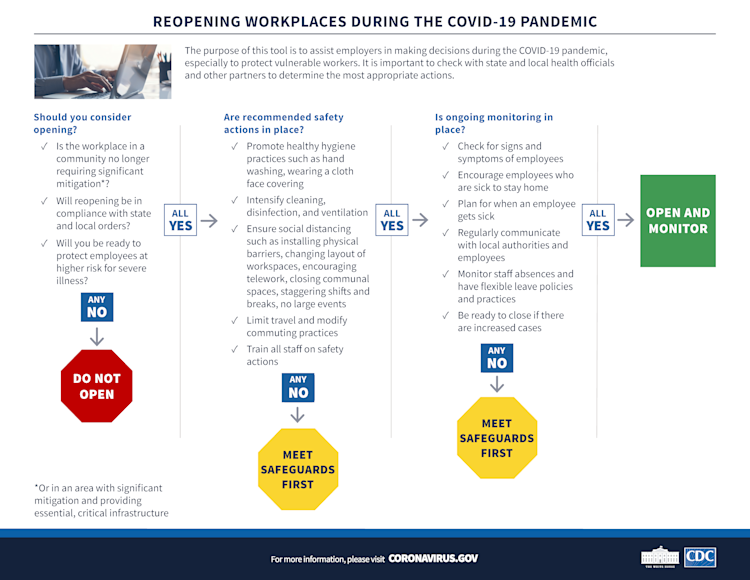10 Tips to Reopen Your Office Safely
Swyft Filings is committed to providing accurate, reliable information to help you make informed decisions for your business. That's why our content is written and edited by professional editors, writers, and subject matter experts. Learn more about how Swyft Filings works, our editorial team and standards, what our customers think of us, and more on our trust page.
Swyft Filings is committed to providing accurate, reliable information to help you make informed decisions for your business. That's why our content is written and edited by professional editors, writers, and subject matter experts. Learn more about how Swyft Filings works, our editorial team and standards, what our customers think of us, and more on our trust page.

As states slowly start to reopen for business, there is a lot of discussion about how to reopen restaurants, retail stores, and other public places. But what about your office? What about the open office concept where people work within a few feet of each other? What should you do before your employees return to your office setting?
Every employer is trying to balance reopening with employee safety. With safety being the more important of the two, here are a few tips to help you reopen your office in a way that provides both protection and productivity.
1. Clean or close break rooms and kitchens
Make sure you have adequate cleaning supplies for the return of your employees. Because of the backlog and high demand, you should order now even if you don’t plan on returning soon. Give the employees the supplies they need to wipe their phones, keyboards, and desks. Have hand sanitizing stations throughout the office and near high traffic doorways where knobs or handles are often touched. You can also require hand-washing breaks.
Increase your cleaning of common areas and doorknobs. It may not be in someone’s job description, but you can rotate the designated person who wipes the common areas down once in the morning and once in the afternoon every day. This step is in addition to your office’s normal janitorial service.
You may want to go as far as to close breakrooms or communal kitchens. Employees can still get coffee or store their lunch in the fridge. However, they should eat at their desk, outside, or some other place to prevent a group of people congregating in a small area. There are good reasons to avoid eating at your desk, but, under the circumstances, this may be a better option than having 25 people packed into an office lunchroom. Staggering shifts can also help prevent a breakroom rush during lunch.
2. Maintain social distance
You’ve heard the mantra already. Don’t get too relaxed on social distancing. We don’t want all of the inflicted pain to be for naught. Move desks or employees around to maintain the recommended six-foot distance. If that’s a challenge in your-open concept office, consider deploying more laptops so employees can move around. Make use of the lobby, conference rooms, and other areas for people to work. The next step may also help your office maintain best social distancing practices.
3. Alternate shifts and adopt remote full time
Creating shifts and allowing more remote work will solve a lot of the real and perceived issues related to opening your office. There are an infinite number of ways to do this, but here are just a few ideas:
Split the office into two teams. Team A comes in on Monday, Wednesday, and Friday for one week while Team B comes in Tuesday and Thursday. Switch days for week two. Continue alternating weeks, and you’ll cut your office use in half. You can make it a little more fun by naming the teams after your branding colors. (i.e., Blue Team and White Team.) If employees share desks or phones, every employee will have to wipe those down before they leave.
Rotate your teams in. Have accounting come in on Monday, HR on Tuesday, marketing on Wednesday, sales on Thursday, and web development on Friday. This way, your teams can come together for collaboration, but not all teams are there at the same time.
Implement permanent remote opportunities. Has your team proven themselves? Let the employees work one week remotely and the other in the office. You can reward employees with certain days off strategically to lower the daily in-office employee count.
Alternate shifts so there is less time when everyone is in the office. If this is not practical, you can at least alternate lunch shifts and breaks to prevent large groups from gathering in the common areas.
4. Temperature checks
You can have a formal policy that prohibits employees from coming to the office if they have a fever, but there will always be one who comes in anyway (or someone simply unaware they have a fever). Larger companies are considering the use of thermal scanners at their entrances. Any reading over a set temperature would then have to go through more discreet and precise checks to determine if they should be in the office that day. Smaller offices can use contactless forehead thermal readers.
You can require everyone to be checked before entry or just have it available for when an employee feels unwell. Using these technologies raises some privacy concerns but, if wisely and compassionately applied, can help keep the office safe and let your employees feel more comfortable about returning.
5. Adjust your PTO
The primary reason an employee is likely to come to the office while sick is because they are out of (or don’t want to use) a sick day. 2020 is the year to increase the bank of available sick days. With the right messaging, you can make it clear that it is a special one-time increase. Your employees will appreciate it, building engagement and loyalty for the long term.
You can also have a “sick but working” policy. If someone is able to work, but has a slight fever or persistent cough, let that person work from home and not have it count as a sick day. Any abuse of this new policy will become apparent.
Your HR and legal professionals will tell you to be careful about this. If someone takes a sick day, they should be off-limits. They should not be expected to respond to emails or messages. If you have a limited pool of sick days, those people are off and should not be expected to stay connected. Having a “sick but working” day allows the person to work from home with clear expectations that they will remain responsive to the needs of the office, but they will not come in and make everyone else uncomfortable or sick.
6. To mask or not to mask?
With various states and localities requiring masks, this may be dictated by the orders in place in your city. Without a mandate, you can still require masks to be worn by employees. This is a touchy subject, and you should consider how closely people are forced to work in your environment and respond to feedback from your employees. You could require masks to be worn only in the common areas and not at individual workstations. Regardless of your choice, have masks available to employees who want to wear them and make masks available to visitors.
7. Have an infected employee plan
If you don’t already have one, develop a plan if one of your in-office workers is diagnosed with COVID-19. There are plenty of articles on developing a plan. An established plan can prevent rumors, panic, and uncertainty. You can have a simple checklist that details:
When the diagnosed employee can return
How to do a deeper clean of important areas
How to contact employees who worked closely with the infected person
If nearby employees should be quarantined, and if so, when they can return
8. Offer flu shots (and hopefully COVID-19 vaccines)
While companies are looking to get back to work for the summer, the flu season is not far away. Use this experience to help prevent the spread of flu in the office. You could offer to have flu shots provided in your office to make sure most of your staff is inoculated. Because of the increased demand and awareness, it is best to plan now.
This will also prevent the use of sick days, so employees will have plenty when it is time to stay home for other illnesses. If you’re an optimist, perhaps there will be a COVID vaccine ready by the time the mobile nursing unit comes to your office with the flu shot.
9. Post policies and communicate
Because your office has been remote, you have likely already increased your communication. When you return, you should continue to over-communicate. There is going to be fear and apprehension about returning to the office. You can acknowledge that fear and apprehension and make sure the employees know the steps you are taking to address those fears before you come back.
It is also a good idea to post your new rules and policies in prominent places for the employees and visitors. If you require masks, post it. If people are required to have their temperature checked, post it. Some of the best advice we got came from a remote veteran at Trademark Engine, Sky Barron, when she said, “If you think you are overcommunicating, you are probably communicating just enough.”
10. Be prepared to close up shop again
Finally, because this is unprecedented, we don’t know how the reopening will go. As always, hope for the best, but prepare for the worst. If there is a spike in cases, expect restrictions to be put back in place. You need to be prepared to go remote again. What did you learn the first time? What can you do better if you have to do it again? Take those lessons and have a plan if you have to close the office again.
While there is a lot to consider before bringing your team back to the office, a little planning can go a long way. The Center for Disease Control provided the included decision tree to help you determine when the time is right. When that time comes, take a few precautions to make the work environment safe for your employees. They will get the message that you care.

Swyft Blog
Everything you need to know about starting your business.
Each and every one of our customers is assigned a personal Business Specialist. You have their direct phone number and email. Have questions? Just call your personal Business Specialist. No need to wait in a pool of phone calls.




